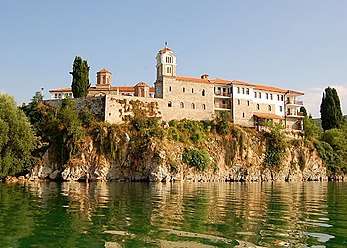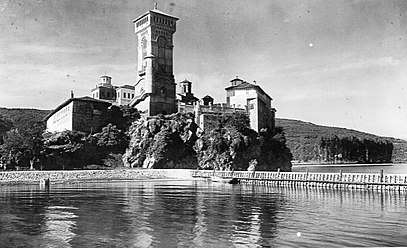Monastery of Saint Naum
The Monastery of Saint Naum (Macedonian: Манастир „Свети Наум“) is an Eastern Orthodox monastery in North Macedonia, named after the medieval Saint Naum who founded it.[1] It is situated along Lake Ohrid, 29 kilometres (18 mi) south of the city of Ohrid.
.jpg) Monastery of Saint Naum | |
 Location within Republic of North Macedonia | |
| Monastery information | |
|---|---|
| Order | Macedonian Orthodox |
| Established | 905 |
| Diocese | Diocese of Debar and Kičevo |
| People | |
| Founder(s) | Saint Naum |
| Site | |
| Location | Ohrid Municipality |
| Coordinates | 40°54′50″N 20°44′25.8″E |
| Public access | yes |
The Lake Ohrid area, including St Naum, is one of the most popular tourist destinations in North Macedonia.[2]
History
The monastery was established in the Bulgarian Empire in 905[3] by St Naum of Ohrid himself. St Naum is also buried in the church.
Since the 16th century, a Greek school had functioned in the monastery.[4] The area where the monastery of St Naum (Albanian: Manastiri „Shën Naum“)[5] lies belonged to Albania for a short period from 1912 until June 28, 1925, when Zog of Albania ceded it to Yugoslavia as a result of negotiations between Albania and Yugoslavia and as a gesture of goodwill.[6]
In the arts
Rebecca West devoted a chapter of Black Lamb and Grey Falcon to her visit to Sveti Naum, which occurred in 1937.
Gallery
|
References
- ohrid.org.mk Archived February 25, 2010, at the Wayback Machine
- Southeast European Times
- Bechev, Dimitar. Historical Dictionary of the Republic of Macedonia. p. 159.
- Skendi, Stavro (1967). The Albanian national awakening, 1878-1912. Princeton University Press. pp. 17.
Greek schools are mentioned in 1723 in nearby Korce.
- Elsie, Robert (2000). "The Christian Saints of Albania". Balkanistica. American Association for South Slavic Studies. 13: 52.
The cult of Saint Naum spread in the first half of the 18th century with the flourishing of Voskopoja KO as a center of Orthodox culture and with the rise of the Archdiocese of Achrida (Ohrid). His fame extended from here southwards to Mount Athos and northwards up to Vienna. His image is to be seen in the frescoes of the churches of Voskopoja, Shipska KO and Vithkuq KO. The Bektashi also went on pilgrimage to the monastery of Saint Naum, believing their holy man Sari Saltik to be buried there. Saint Naum's original feast day was December 23, but in 1727 on the authority of the Archbishop of Achrida, it was changed to June 20 to make pilgrimages less strenuous in the continental climate of the interior of the Balkans.
- Pearson, Owen (2004). Albania and King Zog: independence, republic and monarchy 1908-1939. IB Tauris. p. 248. Retrieved 2010-05-30.
External links
| Wikimedia Commons has media related to Saint Naum Monastery. |

